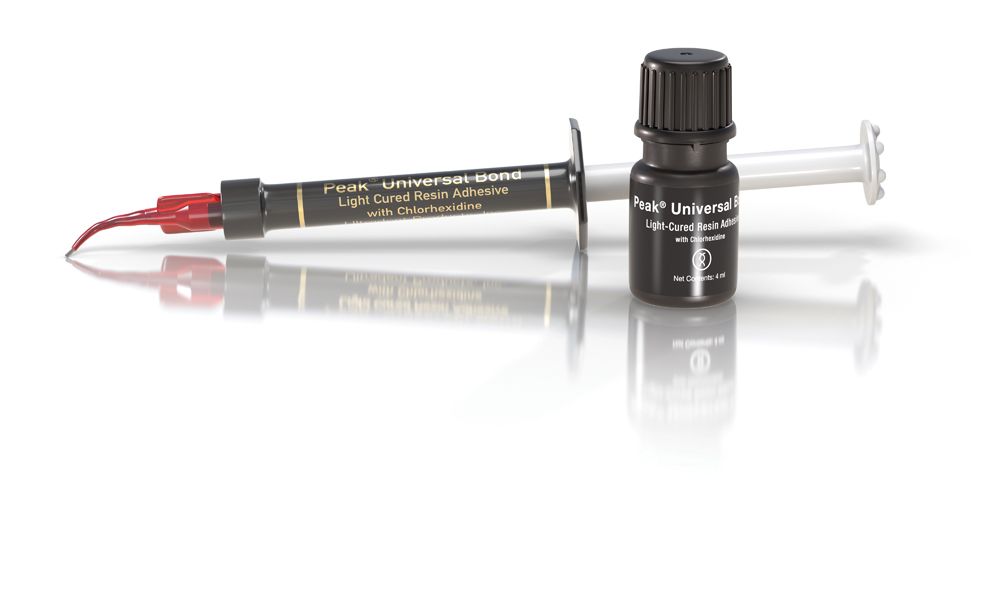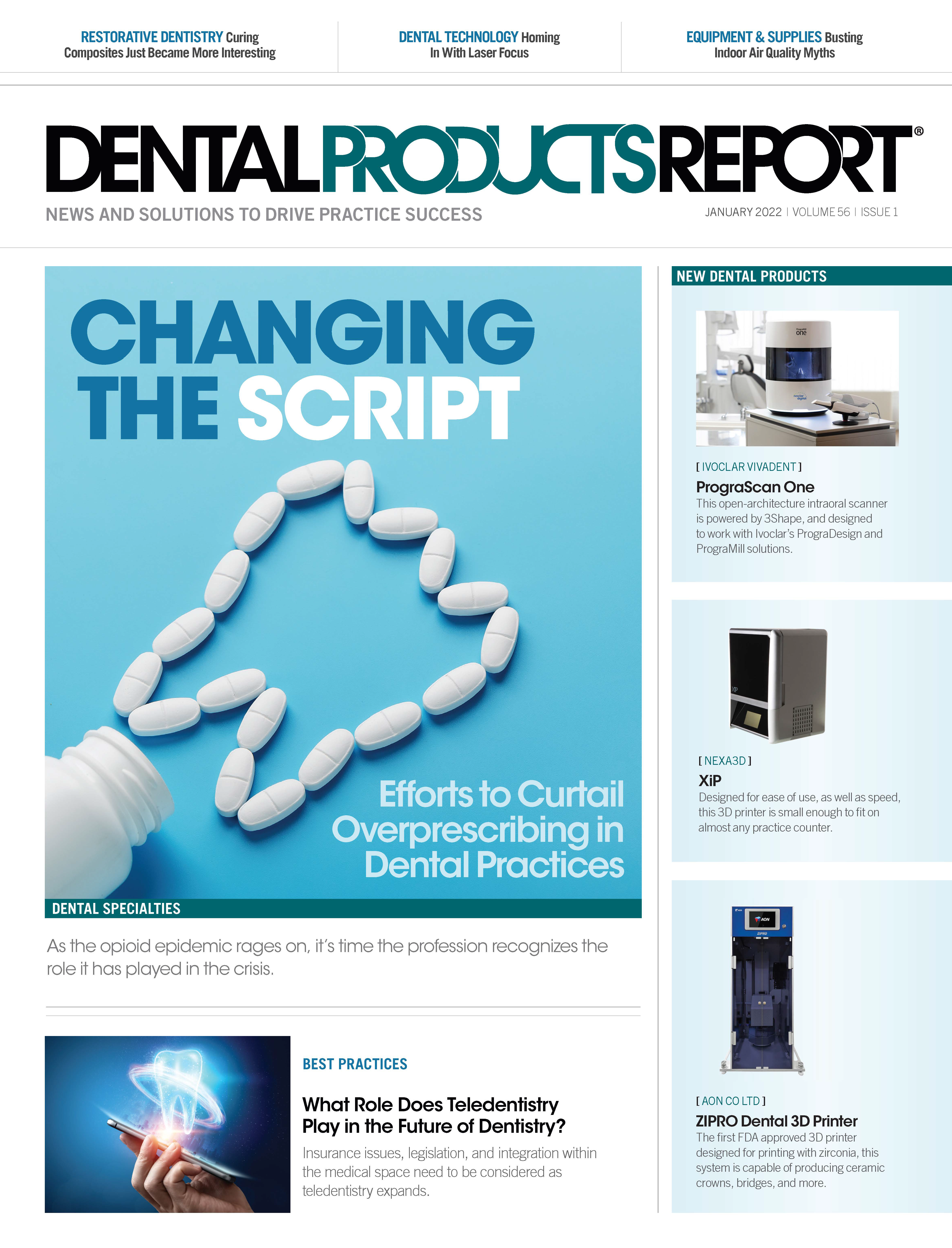If you thumb through a typical dental supply catalogue, you might find 30 different adhesive systems or bonding agents. Every material manufacturer has an offering. Direct sale manufacturers also add to the marketplace.
So the million-dollar question is, “What adhesive should I use?” A lot has happened during the past 4 decades in dental bonding. In the 1980s, doctors were exposed to the early market entries. These were typically fourth-generation, 3-component systems used to adhesively bond composite restorations as an alternative to the staple material at the time, amalgam.
Peak Universal Bond
The Peak Universal Bond adhesive system features a universal bonding agent that is compatible with both self-etch and total-etch techniques. Its universal formulation works with all bonding substrates—including dentin, enamel, porcelain, metal, composite, and zirconia—and provides superior bond strengths, making it the ideal choice for all bonding procedures. The material’s versatile formulation is ideal for indirect and direct bonding.
Ultradent Dental Products Inc.
888-230-1420 | ultradent.com
Fast forwarding, there has been an explosion in adhesive material science and restorative materials. Now doctors not only bond direct restorations to teeth but they also employ a much broader range of indications across pediatric, adult, and geriatric dentistry. The restorative options range from a variety of composite resins—including viscosity variations, layered options, bulk-fill options, dual-cure materials, bioactive materials, desensitizers, and fiber and core buildup materials—to the expanded use of adhesive cementation of indirect restorations made for the continually evolving modern ceramics and related offshoots. In short, doctors rely more than ever on predictable, reliable, and lasting bonds between tooth and restoration.
The Review
The evaluators at Catapult Education clinically reviewed and tested the Peak Universal Bond adhesive system from Ultradent Products Inc. A smaller subset of evaluators also performed unbiased laboratory comparison testing among several market-leading competitive products.
The viscosity and placement precision of Ultra Etch led an evaluator to deem it the “gold standard of etchants.” Once the phosphoric acid is rinsed away, the doctor proceeds with the steps above for delivery of Peak SE to all involved dentin with no concern for overlap onto enamel. The subsequent steps are the same for application of the adhesive. In summary, selective etch approach is used to customize and optimize bonds in most typical clinical scenarios involving both dentin and enamel.
As Catapult Education doctors began to present their findings and feedback on Peak, it quickly became evident how satisfied they were with the outcomes. From general praise on the delivery syringe mechanism (bottle + micro-brush delivery is also available), to notes on restorative outcomes, and finally, confidence in bond performance with regards to the commitment Ultradent Dental Products has as a manufacturer to research and development. This notion of unbiased research proved very important.
Every doctor has seen shear bond strength studies provided by manufacturers in lectures, print, social media, and meeting booths. How can every bonding agent be the best? Every company tries to develop and deliver the best product they possibly can. That said, there is undoubtedly a hierarchy. This is where the smaller subset of evaluators was truly able to investigate the shear bond strength performance of Peak Universal.
About Catapult
Catapult is an organization that consists of more than 50 clinicians spread throughout Canada and the United States. As a company, manufacturers pay a fee for their product to be evaluated and what we deliver are truthful, independent answers from surveys that we develop with them. We have had many products that have either had to be altered before hitting the market or simply never arrived because of our openly honest evaluations. In this way, Catapult assists the manufacturer to avoid potentially releasing a faulty product, or simply a product that needs refinement. Lastly our clients are omnipresent in the industry, small to large, no favoritism, simply reviewing the latest products in our practices.
We were provided a platform to bring what we deemed our personal preferences in bonding agents. We then prepared and bonded composite test buttons on uniformly prepared dentin sample blocks with no manufacturer involvement. The doctors simply followed manufacturer instructions for each material and compared the outcomes. Without naming the competitors tested (essentially all the major players were in the mix), the outcomes can be generalized as follows. Most products performed in a way that I, as the writer, would rate as “good.” This means their shear bond strength (SBS) values were 25 to 35 MPa. Unfortunately, a few of the products tested did not reach that range, and I would rate them as “inadequate.” However, 2 of the products tested yielded results that were a standard deviation higher than those in the “good” category. These 2 products, which yielded average SBS values approaching 50 MPa included Peak Universal, which had the highest SBS values. In fact, several samples recorded forces of more than 60 MPa being required to shear off the composite buttons.
With this background, when a doctor asks, “What adhesive should I use?” my answer really comes down to posing the question, “How strong do you want your bond to be?” As doctors, we must decide if we want to merely restore teeth above a minimum threshold of strength or to approach as high a value as possible. To make an informed decision, it might help to consider this question. What is the cohesive strength of dentin? Logic says if we are restoring a broken-down tooth, it would be nice to get it back to its original level of integrity. After all, we always say, “Nothing’s as good as virgin tooth structure.” Interestingly, the cohesive strength of dentin, meaning the force needed to break a chunk of dentin away from itself, ranges from 70 to 100 MPa.1 Does this knowledge suddenly reframe how we look at tooth reconstruction? Why wouldn’t we want to rebuild teeth to a level rivaling original strength and integrity?
With the Peak Universal Bond adhesive system, Ultradent has developed a flagship product. This was the reason why so many of our Catapult evaluators gave glowing reviews. Several doctors who were not already using Peak in their practice began doing so when they saw the outcomes. Ultimately, Peak earned a resounding Catapult Vote of Confidence.
Reference
1. Jessop N, Denehy GE, Vargas MA. Dentin shear strength: effect of depth and location. Presented at: IADR/AADR/CADR; 1999; Vancouver, BC. Abstract 342.

